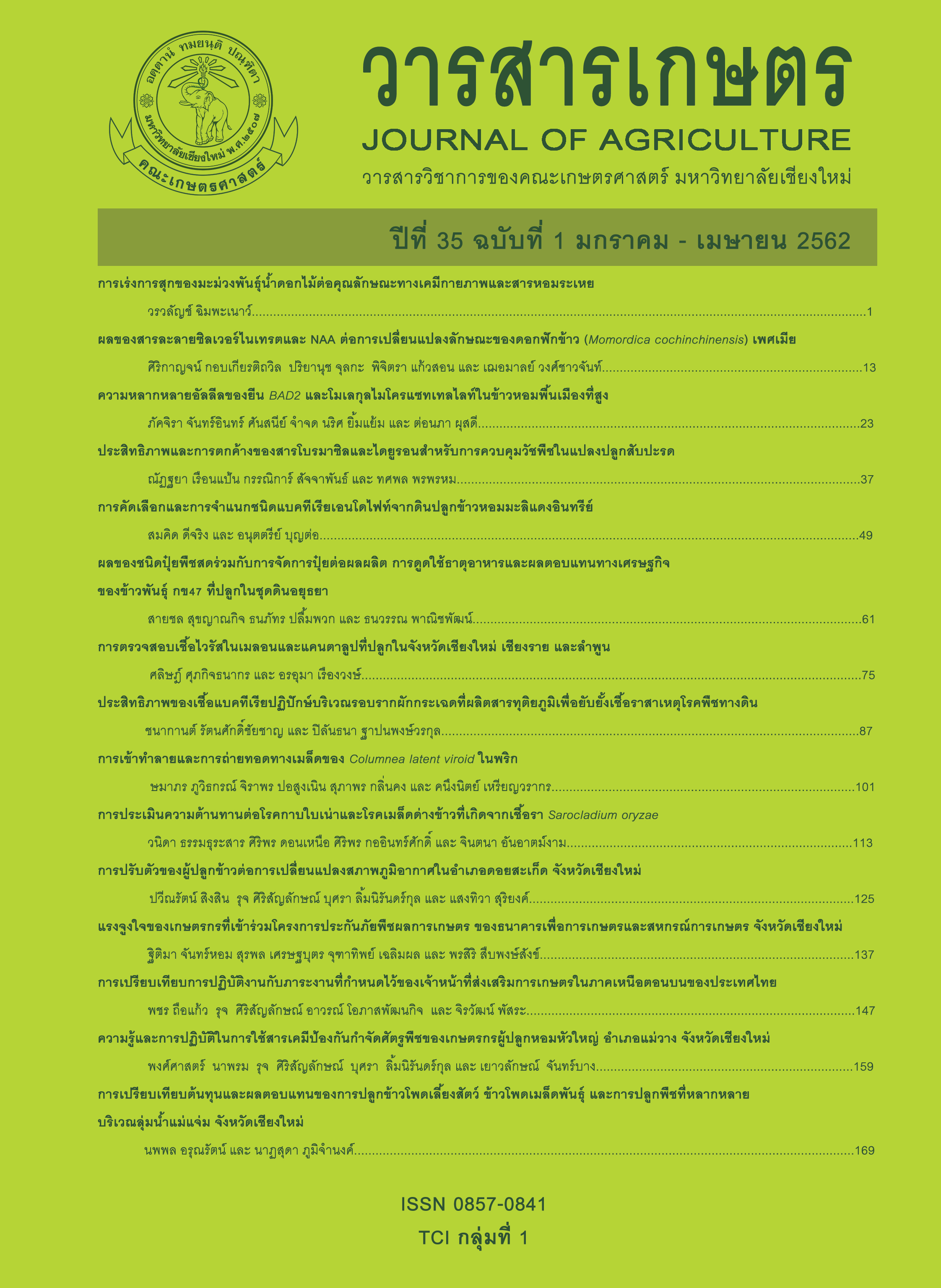ผลของสารละลายซิลเวอร์ไนเทรตและ NAA ต่อการเปลี่ยนแปลงลักษณะของดอกฟักข้าว (<I>Momordica cochinchinensis</I>) เพศเมีย
Main Article Content
บทคัดย่อ
งานวิจัยนี้มีวัตถุประสงค์เพื่อศึกษาผลการใช้สารละลายซิลเวอร์ไนเทรต (AgNO3) และสารละลายซิลเวอร์ไนเทรตร่วมกับ NAA ต่อการเปลี่ยนแปลงลักษณะของดอกฟักข้าวเพศเมีย โดยพ่นสารละลายซิลเวอร์ไนเทรตความเข้มข้น 500 มิลลิกรัมต่อลิตร ให้ต้นฟักข้าวเพศเมียที่มีอายุประมาณ 6 เดือน พ่นสารละลายในเวลา 17.30 น. หลังจากนั้นประมาณ 1 สัปดาห์เมื่อฟักข้าวออกดอกแรกบันทึกผลการเปลี่ยนแปลง ผลการศึกษาพบว่าสามารถชักนำให้เกิดการสร้างก้านชูและอับละอองเกสรเพศผู้ในฟักข้าวเพศเมียทั้งสามกลุ่มตัวอย่างได้แก่ กลุ่มตัวอย่างจากประเทศไทย สาธารณรัฐประชาธิปไตยประชาชนลาว และประเทศเวียดนาม แต่ไม่มีการสร้างละอองเกสรเพศผู้เกิดขึ้น เมื่อพ่นสารละลายซิลเวอร์ไนเทรตความเข้มข้น 500 มิลลิกรัมต่อลิตร ร่วมกับ NAA ความเข้มข้น 1,000 หรือ 2,000 มิลลิกรัมต่อลิตร ให้กับสองตัวอย่างฟักข้าวจากประเทศไทย และลูกผสมระหว่างสาธารณรัฐประชาธิปไตยประชาชนลาวกับประเทศเวียดนาม พบว่าดอกฟักข้าวเพศเมียมีการสร้างก้านชูและอับละอองเกสร ซึ่งละอองเกสรเพศผู้เป็นหมันเช่นเดียวกับการใช้สารละลายซิลเวอร์ไนเทรตเพียงอย่างเดียว รังไข่พัฒนาเป็นผลแต่ไม่พบการสร้างเยื่อหุ้มเมล็ดสีแดงและเมล็ดที่สมบูรณ์ ผลมีอาการขั้วผลแห้งดำและเกิดการหลุดร่วงของผลก่อนถึงระยะเก็บเกี่ยว
Article Details
เอกสารอ้างอิง
กรณ์กาญจน์ ภมรประวัติ. 2556. ฟักข้าว พืชพื้นบ้านมากคุณค่า. สำนักพิมพ์หมอชาวบ้าน, กรุงเทพฯ. 48 หน้า.
กานต์ดา บุญเถื่อน. 2556. ติดปีก ’ฟักข้าว’ ด้วยวิทยาศาสตร์. (ระบบออนไลน์). แหล่งข้อมูล: https://www.bangkokbiznews.com/news/detail/537208 (3 มีนาคม 2561).
ปวันรัตน์ วิหงส์ พัชริน ส่งศรี พลัง สุริหาร คมศร ลมไธสง และ กมล เลิศรัตน์. 2557. ปริมาณสารไลโคปีนและเบต้าแคโรทีนในตัวอย่างฟักข้าวจากสายต้นต่าง ๆ. แก่นเกษตร 42(1)(พิเศษ): 166-171.
พัชริน ส่งศรี. 2555. ฟักข้าวพืชพื้นบ้านคุณค่าสูงเพื่อสุขภาพ. แก่นเกษตร 40(1): 1-6.
พัชรียา บุญกอแก้ว. 2560. สารควบคุมการเจริญเติบโตในพืชสวน. สหมิตรพริ้นติ้งแอนด์พับลิชซิ่ง จำกัด, กรุงเทพฯ. 230 หน้า.
เพ็ญศิริ คงสิทธิ์. 2560. ปริมาณฟักข้าวที่เหมาะสมในการทำน้ำสลัดชนิดข้น. วารสารเกษตร 33(1): 153-161.
วรรณภา เสนาดี. 2554. ฟักข้าว ซูเปอร์ฟรุ้ต สุดยอดพืชพื้นบ้าน. วารสารเคหการเกษตร 35(4): 75-90.
สมพร ภูติยานันต์ ศิริพร โอโกโนกิ เกษร นันทจิต บงกชวรรณ สุตะพาหะ และ บรรยง คันธวะ. 2551. มาตรฐานทางเภสัชเวทฤทธิ์ต้านแบคทีเรีย และเชื้อรา และการพัฒนาเภสัชภัณฑ์จากสารสกัดใบฟักข้าวรักษาโรคผิวหนัง. สำนักงานคณะกรรมการวิจัยแห่งชาติ (วช.), กรุงเทพฯ. 219 หน้า.
Aoki, H., N.Y.M. Kieu, N. Kuze, K. Tomisaka and N.V. Chuyen. 2002. Carotenoid pigments in gac fruit (Momordica cochinchinensis Spreng). Bioscience, Biotechnology, and Biochemistry 66(11): 2479-2482.
Behera, T.K., S. Mishra and A. Pal. 2011. Use of silver thiosulfate and gibberellic acid for induction of hermaphrodite flower in gynoecious lines of bitter gourd (Momordica charantia L.). Cucurbit Genetics Cooperative Report 33-34: 60-61.
den Nijs, A.P.M. and D.L. Visser. 1979. Silver compounds inducing male flowers in gynoecious cucumbers. Cucurbit Genetics Cooperative Report 2: 14-15.
Galun, E., S. Izhar and D. Atsmon. 1965. Determination of relative auxin content in hermaphrodite and andromonoecious Cucumis sativus L. Plant Physiology 40(2): 321-326.
Ghadge, A. G., K. Karmakar, R. S. Devani, J. Banerjee, B. Mohanasundaram, R. K. Sinha, S. Sinha and A. K. Banerjee. 2014. Flower development, pollen fertility and sex expression analyses of three sexual phenotypes of Coccinia grandis. BMC Plant Biology 14: 325, doi: 10.1186/s12870-014-0325-0.
Jadhav, B.P., M.B. Patil, S.Y. Patil, I.S. Halakude and J.C. Rajput. 2018. Development and maintenance of novel source of gynoecy in bitter gourd (Momordica charantia L.). International Journal of Current Research 10(1): 63802-63805.
Kim, I.S., H. Okubo and K. Fujieda. 1992. Endogenous levels of IAA in relation to parthenocarpy in cucumber (Cucumis sativus L.). Scientia Horticulturae 52(1-2): 1-8.
Kumar, V., G. Parvatam and G.A. Ravishankar. 2009. AgNO3 - a potential regulator of ethylene activity and plant growth modulator. Electronic Journal of Biotechnology 12(2), doi: 10.2225/vol12-issue2-fulltext-1.
Li, X.X., F. Kobayashi, H. Ikeura and Y. Hayata. 2011. Chlorophenoxyacetic acid and chloropyridylphenylurea accelerate translocation of photoassimilates to parthenocarpic and seeded fruits of muskmelon (Cucumis melo). Journal of Plant Physiology 168(9): 920-926.
Qian, C., N. Ren, J. Wang, Q. Xu, X. Chen and X. Qi. 2018. Effects of exogenous application of CPPU, NAA and GA4+7 on parthenocarpy and fruit quality in cucumber (Cucumis sativus L.). Food Chemistry 243: 410-413.
Sanwal, S.K., M. Kozak, S. Kumar, B. Singh and B.C. Deka. 2011. Yield improvement through female homosexual hybrids and sex genetics of sweet gourd (Momordica cochinchinensis Spreng.). Acta Physiologiae Plantarum 33(5): 1991-1996.
Thomas, T.D. 2004. In vitro modification of sex expression in mulberry (Morus alba) by ethrel and silver nitrate. Plant Cell, Tissue and Organ Culture 77(3): 277-281.
Tolentino, M.F. and N.M. Cadiz. 2005. Effects of naphthaleneacetic acid (NAA) and gibberellic acid (GA3) on fruit morphology, parthenocarpy, alkaloid content and chlorophyll content in bittergourd (Momordica charantia L. ‘Makiling’). The Philippine Agricultural Scientist 88(1): 35-39.
Trebitsh, T., J. Rudich and J. Riov. 1987. Auxin, biosynthesis of ethylene and sex expression in cucumber (Cucumis sativus). Plant Growth Regulation 5(2): 105-113.
Vuong, L.T., A.A. Franke, L.J. Custer and S.P. Murphy. 2006. Momordica cochinchinensis Spreng. (gac) fruit carotenoids reevaluated. Journal of Food Composition and Analysis 19(6-7): 664-668.
Yamasaki, S. and K. Manabe. 2011. Application of silver nitrate induces functional bisexual flowers in gynoecious cucumber plants (Cucumis sativus L.). Journal of the Japanese Society for Horticultural Science 80(1): 66-75.
Yuan, H., J. Zhang, D. Nageswaran and L. Li. 2015. Carotenoid metabolism and regulation in horticultural crops. Horticulture Research 2: 15036, doi: 10.1038/hortres.2015.36.
Zhang, J., J. Shi, G. Ji, H. Zhang, G. Gong, S. Guo, Y. Ren, J. Fan, S. Tian and Y. Xu. 2017. Modulation of sex expression in four forms of watermelon by gibberellin, ethephon and silver nitrate. Horticultural Plant Journal 3(3): 91-100.


